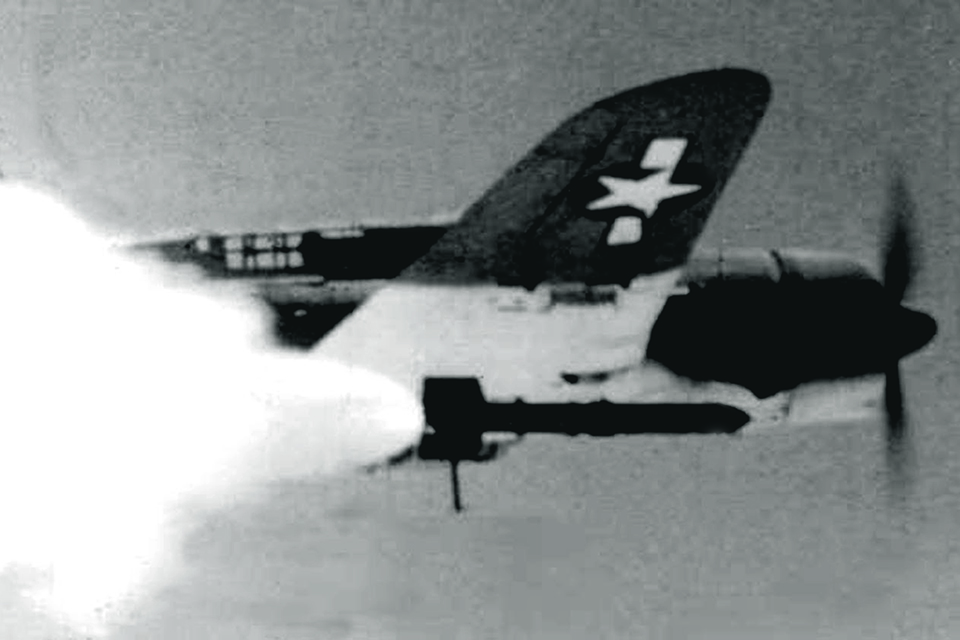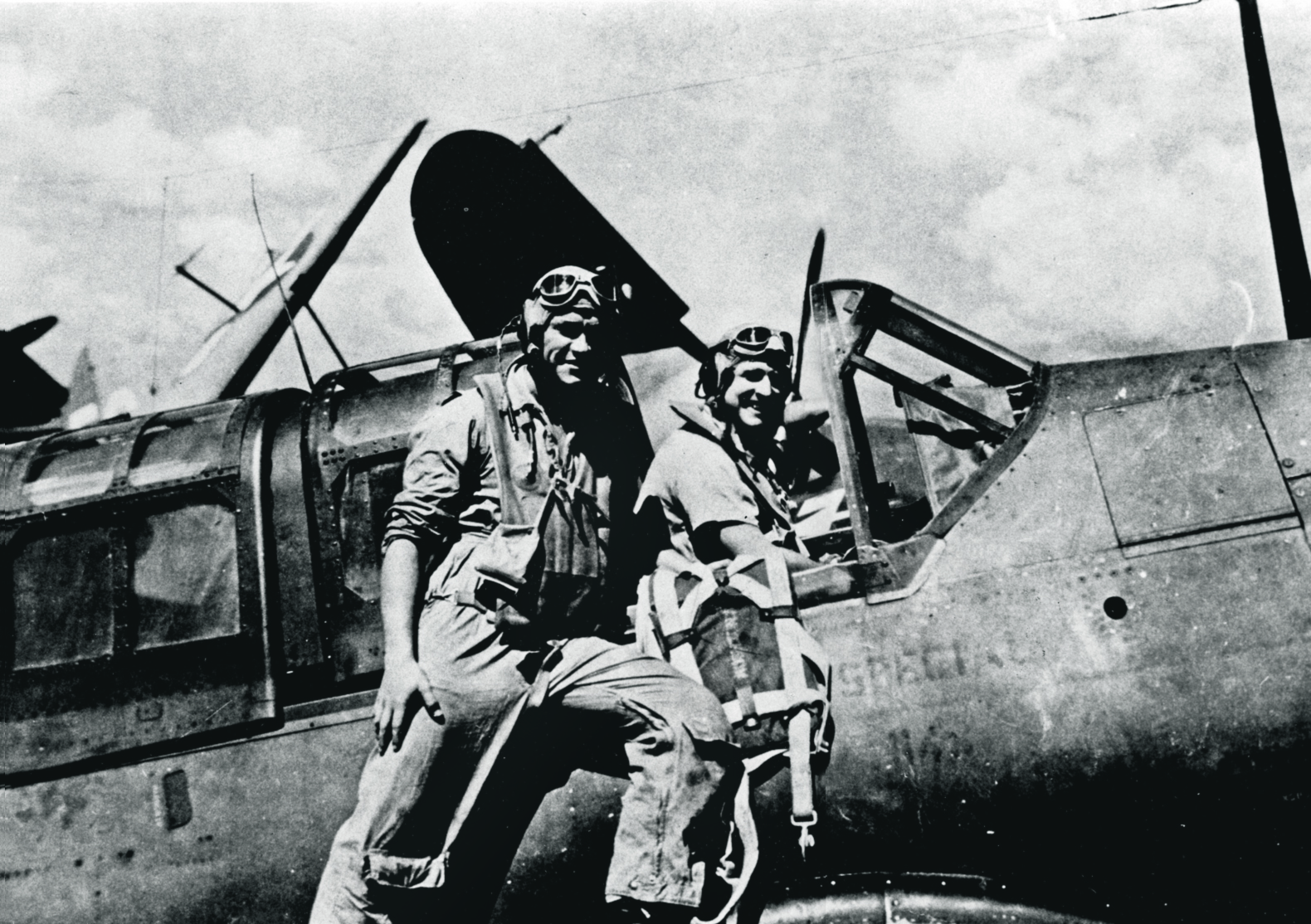U.S. Navy pilot “Griff” Griffin survived intense combat in the Pacific War, then trained for missions that could only be described as suicidal.
In October 1944, as USS bombers launched a second day of strikes on Japanese positions on Luzon, U.S. Navy Ensign Wallace S. “Griff” Griffin Lexington’s dive was at the controls of a Curtiss SB2C-5 Helldiver coming off a bombing run. The day before, he and his gunner had hit their target and all had gone well. But the air group’s intelligence officer didn’t realize the Japanese had since moved most of their AA, concealing the guns in the foliage to wait for the Helldivers as they pulled away from the target.
“We were about 500 feet above the jungle, when all of a sudden I saw tracers coming straight up,” said Griffin. “I flew right into it and they had me bracketed perfectly. I could see the upper wings shredded by bullets coming through and the hydraulic fluid vaporized in pink puffs. It sounded like we were being hit by hundreds of hammers. I just kept praying, ‘Oh God, don’t let them hit the engine.’ If they did, I’d have no place to land. I’d never make the water. The wings had shreds of aluminum sticking out, and my canopy was shattered. My gunner never said a word; I didn’t know if he was dead. I called in to the ship, reporting that I had no hydraulic pressure for flaps, so they had me circle until the rest of the planes had landed….That was one hairy landing.”
Griffin’s Helldiver had 83 holes in it, and the hydraulic cylinder in the starboard wing was blasted out. A bullet had passed just behind his back, leaving a crease in his parachute harness padding. Fortunately his backseater, Eno Leaf, was fine.
Serving with VB-19 during the Marianas and Philippine Sea campaigns, Griffin flew his Helldiver to targets on Guam and Formosa as well as Luzon. During the Battle of Leyte Gulf, the squadron dropped bombs on the Japanese battleships Yamato and Musashi on October 24, 1944, and helped sink four of Japan’s last carriers the next day.
On November 5, two A6M Zeros attacked Lexington in an early kamikaze mission. Griffin had just landed and was off duty when the carrier’s guns started firing at the incoming enemy planes. Gunners shot down the first fighter before it reached the ship, but the second one slammed into the after navigation bridge, killing several men—eight of them VB-19 pilots. Griffin would have been among them had the mess steward not been making him a ham and tomato sandwich at the time. “That sandwich saved my life,” he said.
When Air Group 19 returned Stateside in December 1944, VF-19’s F6F-5 Hellcats, VB- 19’s Helldivers and VT-19’s TBM-1 Avengers were joined by a new fighter-bomber unit consisting of Vought F4U-4 Corsairs, designated VBF-19. Asked to deploy for a second combat tour, Griffin agreed, but stipulated he wanted to fly fighters. “I didn’t want to be responsible for another man’s life,” he explained. “If I made a mistake another man would die with me.”
In January 1945, Griffin reported to NAS Santa Rosa, north of San Francisco.“Our CO was a fighter pilot with nine victories,” he recalled. “Outstanding pilot, but a lousy leader. He expected us to be as good as he was, but that just wasn’t realistic.”VBF-19 lost five men in training accidents within three months. “We learned fighter tactics in the Hellcat, and then moved on to the Corsair,” Griffin said.“I loved flying the F4U, but it was a lousy bomber. At 200 knots in a dive you dropped your landing gear to slow down. And you hit your target only with luck.”
By the spring of 1945, almost every Japanese aircraft carrier had been sunk and most of Japan’s skilled naval aviators were dead. The invasion of the Japanese Home Islands, code-named “Operation Downfall,” was scheduled to begin that November. In a last-ditch effort to deter the invasion armada, Japan readied hundreds of planes for kamikaze missions, many of them hidden in caves throughout the volcanic Japanese islands. Therein lay a new mission for the VBF squadrons’ Corsair pilots: They were slated to become “cave busters,” using the new Tiny Tim solid-fuel rocket, a 10-foot-long brute developed in 1944 by Caltech for the Naval Ordnance Test Station at China Lake, Calif. The Tiny Tim weighed 1,285 pounds, with a 500-pound semi-armor-piercing bomb in an 11.75-inch oil well steel pipe casing. It traveled at 1,000 feet per second and theoretically could hit a target a mile away.
“In May we flew to Marine Corps Air Station Twentynine Palms,” Griffin recalled. “That’s where we first saw the Tiny Tim rocket. They were mounted under the fuselage centerline. You’d line up on a target at about 200 knots. A mile out, pull the bomb release. The rocket just fell away. The plane jumped about 10 feet from the release of over 1,000 pounds. A long lanyard let the rocket clear the propeller, then it pulled loose and the rocket motor ignited.”

Each bomb launch was an awesome spectacle: “Just a loud roar I could hear over the engine, and all of a sudden it lit off with this huge ball of fire and away it went! Scared the hell out of me.” He added, “I never knew if I hit anything in training. You couldn’t aim that thing worth a damn. We were supposed to hit caves and bunkers. ‘Rots of ruck.’ The people on the ground recorded each launch but never told us if we hit a damn thing.” Given his previous combat experience, Griffin fully realized that VBF-19’s new mission was nearly suicidal: “We’d have to come into the target run at a very shallow angle, and we’d be sitting ducks for the anti-aircraft guns pointed at us. I figured most of us would be killed trying to hit those caves.”
With the impending invasion looming, the men of VBF-19 soon began to think of themselves as members of an American kamikaze squadron. But then, as Griffin put it: “President Harry Truman gave the order to drop the atom bombs, and the war ended. That man saved all our lives.”
The Tiny Tim later made a brief combat appearance during the Korean War, though by that time it had been superseded by more advanced weapons. But the concept of flying a single-seat plane laden with a huge weapon at a point target survived. During the Cold War, the U.S. Air Force and Navy trained pilots to fly attack aircraft carrying atomic bombs and perform what was mockingly referred to as the “Idiot Loop.” By flying low and fast, then pulling up into a steep climb just before release, a pilot could theoretically “lob” a nuclear weapon on a ballistic trajectory toward its target.
In 1955 Griffin, then serving as executive officer of VA-155, a Douglas AD-1 Skyraider squadron, underwent training for that risky new mission. “It had to be the most insane maneuver ever dreamed up,” he said. “The AD-1 would stall if you pulled up too fast, but that was the only way to launch that bomb! And then you had to get down low and hit the throttle. Just nuts.
“The Air Force did it with F-86 Sabrejets, but our slow AD-1 would never get clear before the bomb went off. I never actually had to try it. We just learned it in a classroom. I was appalled.” In recognition of the risk involved, the instructor ended his training session by bringing in a silk sash emblazoned with the rising sun, along with a bottle of sake, the traditional last offerings for Japanese kamikaze pilots.
Griffin retired from the Navy in 1965, having experienced more than his share of close calls. Looking back, he’s grateful he never had to fly the “kamikaze” missions for which he was trained. “I never was so scared at anything as I was at the idea of flying a live atom bomb in a suicidal mission,” he said. “Thank God I never had to actually do it.”
Originally published in the May 2013 issue of Aviation History. To subscribe, click here.





